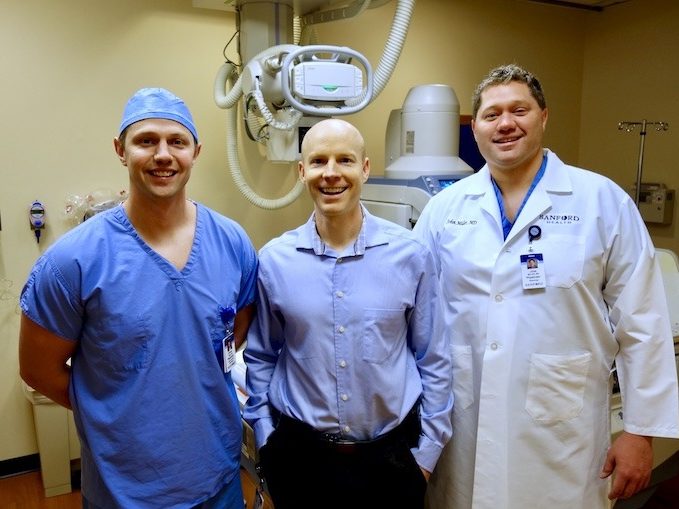Three Sanford Health physicians are collaborating with a medical imaging AI technology company to develop an artificial intelligence tool to identify cancer in radiology images of patients.
BrothersJohn Miller, M.D., andAndrew Miller, M.D., and fellow radiologistJoshua Rampton, M.D.在北达科他的俾斯麦实习。They worked with Sanford Health’s innovation and commercialization team to identify the collaboration partnerInferVision US Inc.
It provided an image annotation and AI training computer server. The physicians pull up de-identified computerized tomography (CT) scans and circle the areas that might be cancerous. These annotated scans are what teach the AI.
The Sanford Health radiologists and InferVision’s data scientists have been collaborating to develop the cancer detecting AI model. They’re currently on the third version of the model.
“Each refined iteration has gotten better at identifying the difference between normal tissue and what is potentially cancerous,” Dr. John Miller said.
“我们不希望它把那些不是癌症的东西叫做癌症,”他说。“该算法继续显示出改进的像素精度。考虑到大量的数据,CT扫描就是病人的切片。每个网格是一个像素片。癌症在那里立体地占据空间。我们衡量的是我们是否得了癌症,我们是否得到了所有的像素。”
And because the algorithm runs in the background, it could spot potentially cancerous tissue even in patients who don’t have a history of cancer.
“It’s a second pair of eyes looking for cancer in these spots that are visually difficult for the human eye to find,” Dr. John Miller said. “It makes the radiologist’s report more accurate and gives patients a clear picture of what’s happening with their disease.”
Novel approach to imaging
Braden Bills, the innovations associate on theinnovation and commercialization teamworking on the project, said the team took a lot of precautions up front to make sure all data are secure.
“We’ve implemented a federate learning setup, where all of the scans used to train the AI are on the Sanford Health network and nothing leaves the network except the trained AI models,” he said.
“As far as the collaboration goes, the radiologists are doing the annotations and providing clinical feedback in real time. And that’s a lot of where the innovation lies, is adding value to the data sets, training the AI models, iterating and being part of the process along the whole way.”
“We get to see it happen before our eyes because we’re working hand-in-hand with InferVision,” added Dr. John Miller, who studied computer science in college. Dr. Andrew Miller got his undergraduate degree in business administration. Dr. Rampton majored in physics. All three received their medical training at the Mayo Clinic.
“The inventors’ technical backgrounds are unique among physicians and have been tremendously valuable during the development of this technology,” Bills said.
Better cancer patient care
Medical professionals strive to get it right but may be more accurate with a little help from technology, Dr. Andrew Miller said.
“这就是人工智能的用武之地,”他说。“我认为,任何好主意都来自于认识到一个问题。作为放射科医生,我们每天要看成千上万的图像。我们工作的一部分就是寻找不同的异常。”
Those differences could indicate cancer. “The goal would be to identify suspicious areas for cancer,” which may improve care through better detection of the disease, Dr. Rampton said.
That is the goal — ensuring people cared for at Sanford Health receive the most accurate diagnosis and treatment possible, which can extend or save lives and reduce health care costs.
“This is all about the patient. It helps the patient and their doctor make a more informed decision,” Dr. John Miller said.
Next steps for AI imaging
除了帮助自己的病人之外,由于与推想公司的合作,这项技术还有可能惠及其他医疗系统服务的人。
“Being able to collaborate with Sanford Health and gain clinical insights from them is what every partner dreams of,” said Tony Gevo, VP of InferVision US Inc. “This kind of working relationship is how world-class applications are developed.”
Miller hopes it can be expanded to scan other parts of the body besides the chest.
“This is a project that has many stages,” he said. “First, can we find the cancer in the chest, and can we do it in a way that’s useful to the patient and doctor? The answer is yes. The next step is can we expand to the abdomen and neck and pelvis? We’re setting off on a journey. We’re taking our first couple of steps. Right now it seems like we’re making good progress and have a good start.”
Sanford Health is focused on innovation to bring new ideas to market that improve the health and well-being of our patients, people and communities. It values the ideas and problem-solving ability of its nurses, physicians, researchers, clinical workers and support staff. Any employee with an idea for a device, therapy, software, tool or other method that helps patients is encouraged tocontact the innovations team.
Learn more
- Unique AI tool helps Sanford Health schedule nurses
- Sleep apnea AI tool uses 0s and 1s to increase ZZZs
- AI, spinoffs & new partners among Sanford Health innovations
…
Posted InBismarck,Cancer,Cancer Screenings,Imaging,Innovations
